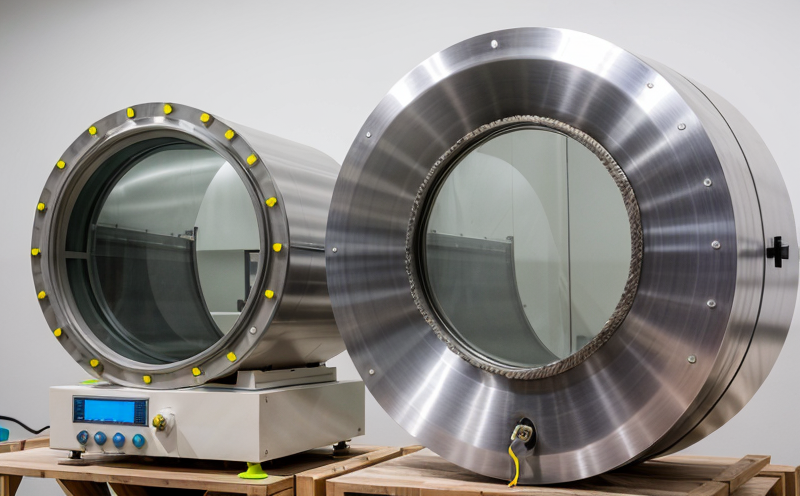ASTM C1891 Shielding Efficiency of Tungsten-Based Materials
The ASTM C1891 standard provides a method to measure the shielding efficiency of tungsten-based materials, which are critical in various industries including nuclear power and medical imaging. This test is essential for ensuring that materials used in radiation environments meet the necessary standards for protecting personnel from harmful ionizing radiation.
ASTM C1891 involves subjecting a sample to gamma or X-ray radiation of known intensity and measuring the amount of energy absorbed by the material before it passes through. The efficiency is calculated based on the reduction in beam intensity after passage through the sample compared to its initial value. This method allows for accurate quantification of shielding performance, which is crucial for applications where minimal exposure to radiation is paramount.
The testing process begins with careful preparation and selection of samples representative of those used in real-world conditions. Sample thicknesses are precisely controlled according to ASTM C1891 guidelines, ensuring consistent test results that are directly applicable to field use. The chosen radiation source must be appropriate for the material being tested; typically, gamma rays from a Cobalt-60 source or X-rays generated by an electron accelerator are used.
Instrumentation plays a crucial role in ASTM C1891 testing. High-resolution detectors capable of accurately measuring changes in radiation intensity over small energy ranges are essential. These instruments must adhere to strict calibration procedures to ensure reliable measurements throughout the test cycle. Data acquisition systems collect and process this information, producing detailed reports on shielding efficiency.
ASTM C1891 also specifies acceptance criteria that define acceptable levels of shielding efficiency based on material type and application requirements. Compliance with these standards ensures that materials meet industry expectations for safety and performance in radiation environments.
Understanding the implications of ASTM C1891 testing is vital for ensuring compliance with relevant regulations and maintaining high-quality standards within your organization. By adhering to this method, you can ensure that your tungsten-based materials provide adequate protection against harmful ionizing radiation, thereby safeguarding both personnel health and operational integrity.
Scope and Methodology
This table outlines the key steps in ASTM C1891 testing:
| Step | Description |
|---|---|
| Sample Preparation | Select representative samples of tungsten-based materials, ensuring they meet specified dimensions and tolerances. |
| Radiation Exposure | |
| Data Collection | Measure radiation intensity before and after passing through the sample using calibrated detectors. |
| Efficiency Calculation | Determine shielding efficiency by comparing pre- and post-sample radiation intensities. |
| Acceptance Criteria | Evaluate results against industry standards to ensure compliance. |
The methodology described in ASTM C1891 ensures consistent and accurate assessment of tungsten-based materials' shielding capabilities. By following these steps meticulously, laboratories can provide reliable data supporting material selection and application design.
Benefits
- Ensures compliance with industry standards for radiation protection.
- Promotes safer working environments by verifying effective shielding performance.
- Aids in optimizing material usage through precise efficiency assessments.
- Supports regulatory requirements and certification processes.
- Facilitates continuous improvement of products and processes.
- Reduces risks associated with improper radiation exposure.
- Increases confidence in product quality and reliability.
- Facilitates international collaboration by adhering to recognized standards.
The benefits of ASTM C1891 testing extend beyond mere compliance; they contribute significantly to enhancing overall safety, efficiency, and regulatory satisfaction within your organization.
Eurolab Advantages
- Expertise: Our team comprises experienced professionals specializing in radiation and nuclear testing.
- Accreditation: We are ISO/IEC 17025 accredited, ensuring the highest standards of laboratory excellence.
- Innovative Solutions: Leveraging cutting-edge technology and methodologies to meet evolving industry needs.
- Comprehensive Services: Offering a wide range of services beyond ASTM C1891 to support your entire project lifecycle.
- Global Reach: With facilities worldwide, we provide seamless service across different time zones and geographical locations.
- Certified Personnel: Our staff are trained in the latest techniques and protocols for accurate testing results.
- Prompt Reporting: Timely delivery of detailed reports to keep your projects on schedule.
Eurolab's commitment to quality, innovation, and customer satisfaction sets us apart as a premier choice for ASTM C1891 shielding efficiency testing. Partner with us to ensure that your tungsten-based materials meet the highest standards of safety and effectiveness.





